I really have to stop doing stuff like that with the titles…
As a section of the photo gallery shows, while I lived in Florida I ‘maintained’ a small saltwater aquarium – not exactly intentionally, and certainly not in the way that aquarium enthusiasts do. Instead, it was born simply from finding critters of interest in the nearby sound, or a little further off on the Atlantic shore, and wanting to photograph them. Actual in situ photography, capturing images of aquatic animals within their habitats, is very involved and quite expensive, something that wasn’t going to happen then (or now, for that matter) – not just some highly specialized equipment, but also the ability for the operator to remain for adequate times within an environment that they are not at all suited for, and must be, uh, suited for. You know, scuba gear and all that. But the smaller critters, at least, could be temporarily housed in a small aquarium, which also provided lots of options for setting and lighting.
For reasons I honestly cannot explain, ‘fish’ do not really count among the subjects in which I have an interest; most piscine species are remarkably boring to me, no matter how colorful they may get. Only the bizarre, or at least subtly malevolent, species get some attention. But also inexplicably, I find the crustaceans to be fascinating.
Collecting small examples of crustaceans in the Indian River Lagoon (the ‘Lagoon’ part invariably dropped in all references by the locals) was easy, almost effortless. Just about anything underwater would host some small species of crab, and careful observation when snorkeling would reveal plenty of examples. I would go out once or twice a week for fresh water and seaweed, which would contain food sources for the tank residents, and would scout around the area for anything new or interesting. At times, this would be done at night, since there were more species active then, and more visible since I would hold the flashlight underwater, eliminating any obscuring reflections from the surface; I could also adjust the angle of lighting to help spot something better. One night, I espied two tiny ruby reflections on a piling, coming and going with the light angle, and eventually determined that I was seeing some minuscule nearly-transparent species, though at that time I hadn’t determined what it was. I eased a shallow bowl into the water and came up behind it, successfully scooping it up and bringing it to the surface. Just as I was transferring it into a jar, it gave a defensive kick and flipped itself out of the bowl, wriggled momentarily on the dock I lay upon, and dropped back into the water. I was quite chagrined, since I still hadn’t determined what it was, except for perhaps 2 cm in length. Looking defeatedly back into the water, I found that it had either returned to almost exactly the same position, or another was now occupying the space. With a little more care this time, I effectively captured it and got it into the jar, to be closely examined back home.
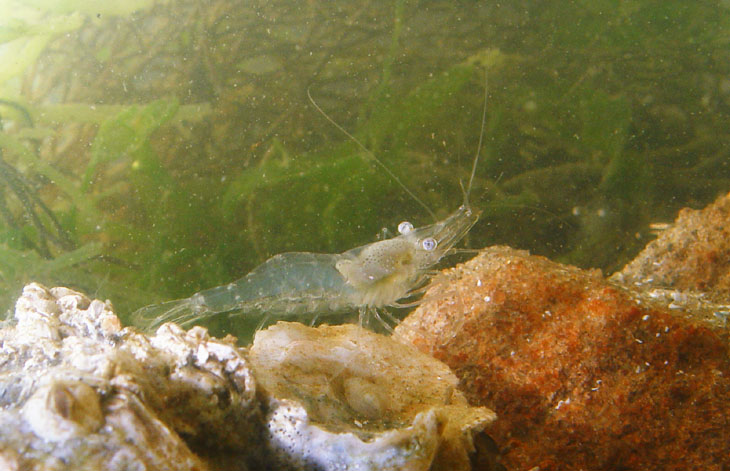
 What I had was eventually determined to be a grass shrimp (Palaemonetes pugio,) sometimes sold in aquarium shops as ‘ghost shrimp,’ which seems a more appropriate name. They are remarkably transparent, which makes them challenging to photograph, but also quite interesting to observe. While they can walk about on the bottom and forage, more often they simply drift through the water, suspended by the frantic actions of the little limbs underneath their tails, called pleopods, which thrash in a mad blur that causes the shrimp to waft along as if propelled by a gentle subsurface current. The detection of any threat by those long antennae, however, provokes a flip of the entire tail, flicking the shrimp backwards so quickly they almost seem to vanish and reappear a few centimeters away. I usually had several in the tank at once, and they found more than enough to eat attached to the seaweed I would collect. Nothing else in the tank was inclined to eat them, so they seemed to lead a cushy, carefree existence during their time as my guests.
What I had was eventually determined to be a grass shrimp (Palaemonetes pugio,) sometimes sold in aquarium shops as ‘ghost shrimp,’ which seems a more appropriate name. They are remarkably transparent, which makes them challenging to photograph, but also quite interesting to observe. While they can walk about on the bottom and forage, more often they simply drift through the water, suspended by the frantic actions of the little limbs underneath their tails, called pleopods, which thrash in a mad blur that causes the shrimp to waft along as if propelled by a gentle subsurface current. The detection of any threat by those long antennae, however, provokes a flip of the entire tail, flicking the shrimp backwards so quickly they almost seem to vanish and reappear a few centimeters away. I usually had several in the tank at once, and they found more than enough to eat attached to the seaweed I would collect. Nothing else in the tank was inclined to eat them, so they seemed to lead a cushy, carefree existence during their time as my guests.
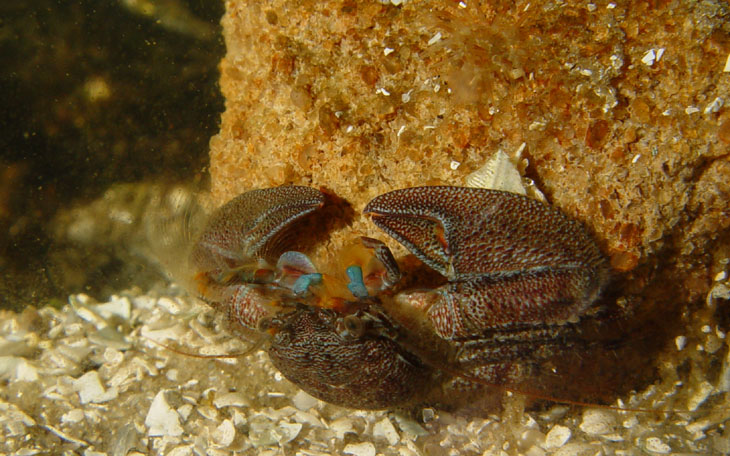
Another species that I usually had within the tank were the porcelain crabs, one of two species (or perhaps examples of both): Petrolisthes armatus or Porcellana sayana. Small and very flat, they could press themselves so tight to any surface they could be challenging to collect, but I’m glad I made the efforts, because they were always entertaining to observe. Many crab species are scavengers, finding deceased critters or loose organic matter to tear up and feed upon, and on first glance these seemed well-equipped for such a diet, possessing quite large pincers (chelipeds) for their size. However, I never observed any such behavior; instead, the porcelain crabs were filter feeders, sweeping through the water with two delicate forelimbs topped with broad fans, collecting plankton and microorganisms that they would wipe off into their mouthparts. These fans are actually visible in the pic above; one tucked into cleaning position between the right pincer and the blue mouthparts (don’t ask me why blue,) the other extended over the left elbow. Or there’s this view:
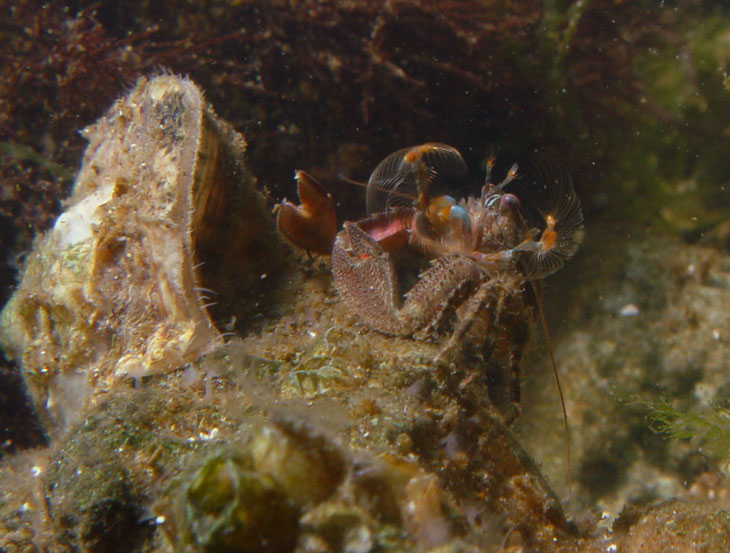
They were always very mellow, insofar as any such personality might be assigned to a crustacean; not territorial or competitive, not dangerous to other residents in the tank, and not aggressive. Later on I found out that they are an approved addition to any saltwater aquarium for exactly these traits, since many species that can be obtained are incompatible with others, and that whole food-chain thing means you have to pick one or the other lest they make that choice themselves. Most amusing was watching them actually sitting atop a hermit crab many times larger, riding along with aplomb.
While I had them, I obtained a brief segment of video that shows the feeding behavior; this was taken with a Sony DSC F717 camera, not exactly known for its video quality, so this isn’t going to impress you, but it does show how those little feeding arms work, as well as a crab’s glare-equivalent towards a blundering amphipod:
Perhaps the most charming members of the crustacean family are the hermit crabs, and it’s not just me saying that – people that find crabs to be creepy often seem just fine with hermit crabs, which somehow manage to unlock the ‘cute’ achievement. Many crabs are actually shy, but few people get to witness this; it’s the hermits that demonstrate it routinely, as well as having the pleasant exterior of a discarded snail shell. I suspect it also has something to do with their legs being gathered in front, breaking that visual pattern of a lot of legs on either side like spiders. Loads of tiny hermit crabs could be found in the lagoon, and they fed happily on the algae that would come along with the seaweed I collected, so I always had at least a half-dozen in the tank, usually more. Most of these were roughly pea-sized, and trundled around the tank busily during just about any observation; occasionally, I would find a much-larger thinstripe hermit crab (Clibanarius vittatus) that I would collect for a few photos, but never keep more than a day or so, because there simply wasn’t enough food for them in the tank, and they likely would have reduced the populations of other species that I had. The little guys, however, could stay indefinitely.
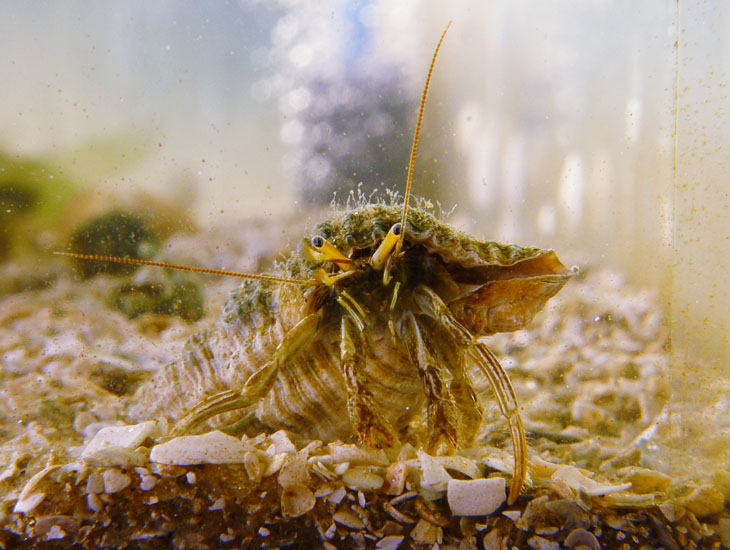
Looking at this image just now, I realize it seems to have the same marking as the larger ones that I’ve positively identified as thinstripe hermit crabs, so it’s possible this is a much smaller, younger example; I have no idea how big they are when born. To give an idea of the size disparity, compare this pic with the one here, especially noting the crushed shell underfoot – if it helps, this one is probably half as wide, measured across its shell home, as the porcelain crab atop the larger species.
Now, I don’t want to give a completely misleading impression; I did have a couple of fish in the aquarium. The most distinctive was the flounder, a very small specimen, actually the second that I’d caught in the lagoon of almost exactly the same size. The first I’d seen undulating on the surface while I was wading, but I wasn’t maintaining the tank then and didn’t keep it beyond the time it took to obtain a couple of slides (yes, film – ask your parents.) The second was a lucky capture, and borderline stupid: I was snorkeling and gently pushing on the sand with my hands, when I felt something wriggle under my palm. I immediately closed my hand over it to enclose it, which might have been bad had it been something with proper defenses – I was in a saltwater sound that housed things like stingrays, after all. But my suspicions were correct, and I brought home another flounder, which remained in the tank for quite a while.
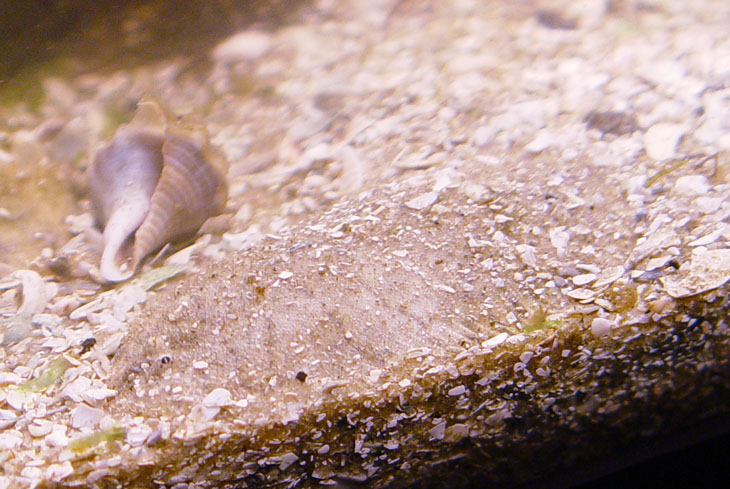
This pic is far from the most illustrative of anatomy, but does a great job of showing how well they blend in. You can see the faint difference in color and texture in comparison to the crushed shell substrate, and at far left, directly under the snail shell, a dark spot (with an apparent white slit pupil, actually only a bit of shell) that marks one of the googly eyes that flounder have; the other sits right alongside it, facing entirely away from us and thus invisible in this shot – the flounder is ‘facing,’ as poorly as that word can be used here, directly left. At least, that’s where the mouth sits, with the tail to the right. Here’s a bottom view from one of the times it was resting vertically against the glass, facing the same way.
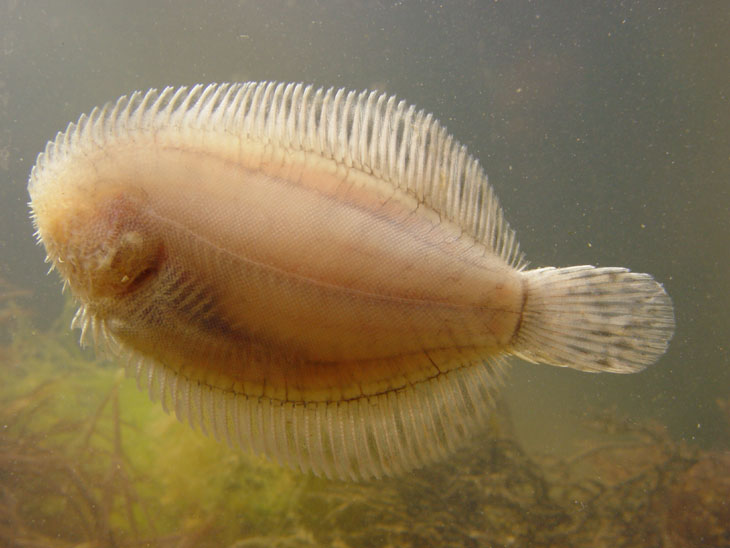
This one was just big enough to hide a quarter coin underneath, but a silver dollar would have shown around the edges, so about 2 cm wide and 3 long. I am assuming this is a young one, but I’m not sure. Flounders are born looking much like other fish, their anatomy arranged to swim in a typical vertical orientation, but they instead stay on their side along the bottom, and soon their ‘bottom’ eye starts to migrate sideways around the head to join the other eye on ‘top;‘ since this had already happened, I have to assume mine was not terribly young, but I honestly don’t know how long it takes, or even what species this is. Notice that you can still see the gill on this side.
While the flounder could be disturbed from lurking on the bottom, I’d watched the small hermit crabs amble over top any number of times without provoking a response; whether the crabs themselves noticed any change underfoot I cannot say.
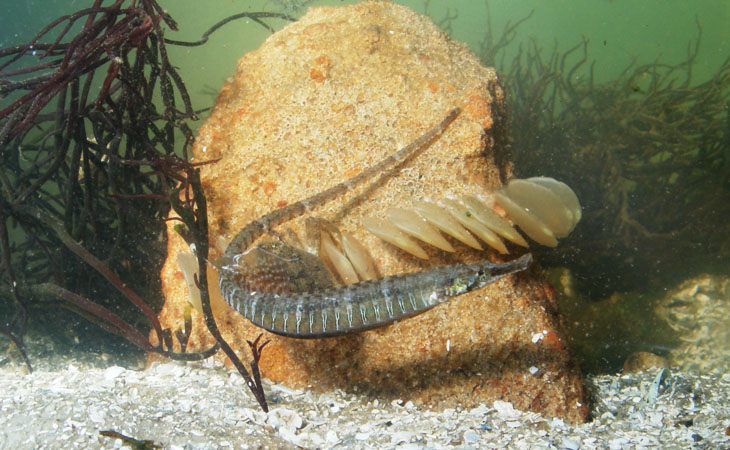
Another fish species I had, briefly, were Gulf pipefish (Syngnathus scovelli.) Basically resembling stretched out seahorses, I was delighted to snag one when collecting seaweed, and began watching for them when snorkeling. I couldn’t keep them in the tank long, however, since they consumed a lot of food, primarily things like brine shrimp, and I rarely had many of those in the tank. The pipefish seemed fond of one particular spot that I visited in the lagoon, only a handful of meters wide, and I never determined why that section got all the attention, since it seemed indistinguishable from the rest; perhaps I just happened upon a breeding patch. One type of longneedle pine overhanging that area of the lagoon routinely dropped short twigs, the base stem of the needle sprays, and the shape and size of these was nearly identical to the pipefish, meaning I got a lot of false alarms, and on at least two occasions misidentified pipefish as a twig, clued in to my mistake because the authentic twigs never, during my observations, swam away. The pipefish (and the twigs, really) measured about 8cm in length, perhaps 4-6mm in width. The one shown here is curled in front of a string of snail egg cases (almost certainly of the king’s crown conch, which I had briefly in the tank) and a small crab, hiding behind the dorsal fin – you can see the legs peeking out. Later this same day, one of the grass shrimp hatched out a brood, filling the water with tiny newborns – briefly. The couple of pipefish I had ate them like popcorn and had the water clear within an hour. Noticing their efforts, I snagged one of the newborn shrimp for some macro work; what you see below measures 4-5mm in length. It was photographed in the translucent lid of a film can, allowing for backlighting and also a shallow depth of water so the shrimp couldn’t wander out of focus, this being before I’d made my “tiny tanks.”
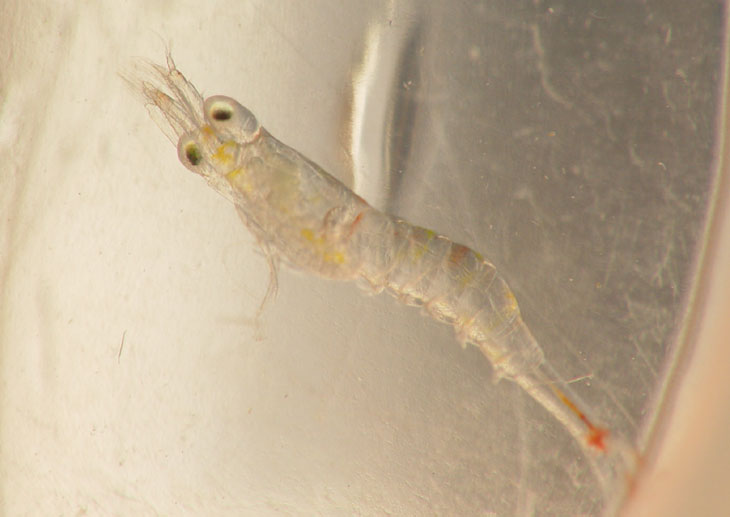
I had one other fish species that stayed for a while, a type of goby I think – these seemed to have a symbiotic relationship with some of the crab species out in the lagoon, since they were often found in close proximity. The gobies tended to like little hiding places, and I learned that if I spotted both halves of an empty mussel shell still hooked together, I should close the shells before picking them up; more than 25% of the times I would capture a goby within. At one point, I watched, and video’ed, a hermit crab that appeared to be very deliberately herding the goby across the tank, though whether this was correct, and what purpose it would serve, remains unanswered.
 The red rock with the snail’s eggs, seen behind the pipefish above, was a notably bare exception (though it appears in a ridiculous number of my images,) since most of the rocks I had in the aquarium were ‘living’ rock – in other words, bearing living matter thereon. I was startled to see one of the stones I collected, early on in the tank’s history, sprout a garden of little anemones soon after putting it in the water; it had spent the short trip back from the lagoon on the floor of the car out of water, because I hadn’t realized it was occupied. The anemones retract protectively when threatened and become very low key, but will otherwise wave their blossom-like heads in the current collecting food. Unlike flowers however, these critters could move about, not just ingesting food but actually changing locations within the tank, albeit at much less than a snail’s pace. They would also reproduce by dropping new, tiny versions around their base, and when they did this on the aquarium sides I would have to scrape them off. I rarely saw them feeding, but they seemed to be finding enough, and this one captured quite a mouthful. Or somethingful.
The red rock with the snail’s eggs, seen behind the pipefish above, was a notably bare exception (though it appears in a ridiculous number of my images,) since most of the rocks I had in the aquarium were ‘living’ rock – in other words, bearing living matter thereon. I was startled to see one of the stones I collected, early on in the tank’s history, sprout a garden of little anemones soon after putting it in the water; it had spent the short trip back from the lagoon on the floor of the car out of water, because I hadn’t realized it was occupied. The anemones retract protectively when threatened and become very low key, but will otherwise wave their blossom-like heads in the current collecting food. Unlike flowers however, these critters could move about, not just ingesting food but actually changing locations within the tank, albeit at much less than a snail’s pace. They would also reproduce by dropping new, tiny versions around their base, and when they did this on the aquarium sides I would have to scrape them off. I rarely saw them feeding, but they seemed to be finding enough, and this one captured quite a mouthful. Or somethingful.
The rocks also supported one or two oysters (one seen alongside the porcelain crab feeding further up the page) and a serious collection of acorn barnacles, which could be found everywhere in the lagoon. They’re fond of attaching to and riding along with horseshoe crabs, and I’ve even found one on the leg of a hermit crab. You can be excused if you thought of them as molluscs like clams and oysters, but they’re crustaceans instead, more closely related to the crabs seen here, and their juvenile stages are quite mobile. Seriously, check out this page, because they’re fascinating creatures and deserve the attention.
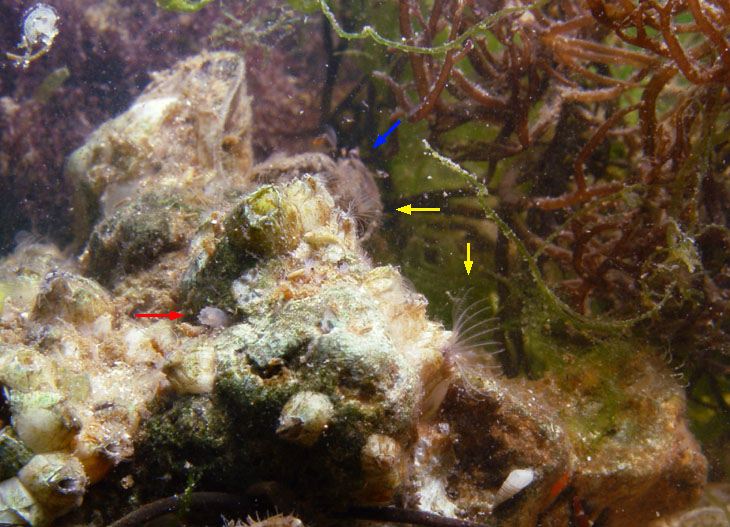
This image was actually taken just a short while before the one above showing the porcelain crab feeding; you can see it creeping into position, marked by the blue arrow. The yellow arrows show barnacles feeding (actually, just about everything to the lower left are barnacles,) and the red arrow is a retracted anemone. The seaweed in the background isn’t growing, just recently collected, which distributed a new batch of food sources into the water and often sparked a lot of activity. Aside from the aerator and fresh water (about 20-40% of aquarium capacity cycled per week from the lagoon,) that was pretty much all I did to maintain the tank, and the residents were often released after I had observed and photographed them sufficiently.
While I have done some half-hearted attempts at aquarium photography since moving back to North Carolina from Florida, the water sources here simply cannot compete with the variety and fertility of that saltwater sound, which also housed stingrays, dolphins, manatees, ctenophores, and plenty of others. I’ve posted before about spider crab camouflage, pistol shrimp, and the supremely cool bioluminescence that could occur in high summer. It’s a fascinating locale.
I will close with what is almost a self-portrait, obtained by accident while getting pics of the redfin needlefish featured earlier. When it’s warm, I rarely have a shirt on, much to everyone’s horror…





















































